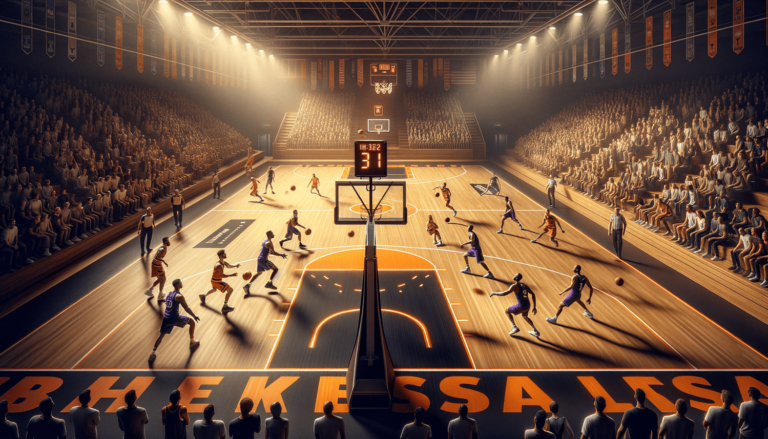
Illegal Formation Rule in Basketball: What It Means
Written by: Basketball Universe
Last updated:

Welcome to the fascinating world of basketball rules, where even the most experienced fans can still learn a thing or two! In this blog post, we’ll dive into the depths of the mysterious ‘Illegal Formation Rule’ in basketball – a topic bound to pique your curiosity. Get ready to expand your hoops knowledge and impress your fellow enthusiasts as we uncover the meaning, importance, and impact of this somewhat obscure regulation in the game we all love. So grab your whistle, tighten your sneakers, and let’s unravel the intricacies of the Illegal Formation Rule together!
Illegal Formation Rule in Basketball: What It Means
The Illegal Formation Rule in basketball refers to situations where players intentionally position themselves to violate the rules of the game, often with the aim of gaining an unfair competitive advantage. Common examples include lane violations during free throws, illegal screens or picks, and illegal positioning when inbounding the ball. Understanding and identifying these infractions are crucial for referees in maintaining fair competition and ensuring teams follow the spirit of basketball.
Understanding the Importance of Formation Rules in Basketball
In the fast-paced, high-energy game of basketball, players are constantly moving, making quick decisions, and engaging in intricate plays. It might surprise you to learn just how many basketball rules guide and shape these actions on the court. While some rules are well-known and relatively easy to understand, others, such as the Illegal Formation Rule, can be more complex and elusive. In this blog post, you’ll learn how these formation rules contribute to the overall gameplay and provide structure for a fair and enjoyable basketball experience.
Delving into the Most Common Illegal Formations
Lane Violations During Free Throws
One of the most prevalent illegal formations in basketball occurs during free throw attempts. The crucial rule here is the ‘three-second free throw lane violation.’ As the name suggests, players are prohibited from entering or leaving the marked lane spaces within three seconds of the free throw being released. The free throw shooter also has 10 seconds to release the shot after the referee has handed them the ball. Understanding these timing restrictions helps players avoid costly lane violations during games, ensuring the spirit of basketball rules is upheld.
Illegal Screens or Picks
Another common illegal formation in basketball is the improper execution of screens or picks. These are maneuvers used by offensive players to create space for their teammates by obstructing the progress of defenders. To perform a legal screen, the screener must have both feet planted, facing the direction of the player they are screening or perpendicular to the defender. Contact should be kept to a minimum, and a screener must not extend their arms, legs, or move to actively seek contact with the defender. Understanding how to set screens and picks without committing a foul is a valuable skill for any player, contributing to the harmony and flow of the game.
Illegal Positioning When Inbounding the Ball
Inbounding the ball is an integral part of basketball, often occurring after a made basket, an out-of-bounds play, or a dead ball situation. To correctly inbound the ball, a player must follow strict positioning rules. For example, the inbounding player may not cross the boundary line or physically enter the court until the ball has been legally touched. Additionally, defenders must allow inbounders enough space to make a pass, avoiding actions that impede the passer’s progress. Understanding the nuances of inbound play is vital, as improper positioning could lead to turnovers or unnecessary fouls.
Why Illegal Formations Are a Major Concern in Basketball
At its core, basketball is a highly strategic game that requires both skill and mental acuity. While employing clever tactics is part of the excitement, it’s crucial that these tactics remain within the boundaries set by basketball rules. Illegal formations exploit the rules, treading the line between fair play and cheating to gain a competitive edge.
From a player’s perspective, adhering to the rules and avoiding illegal formations is essential for maintaining a clean reputation and demonstrating sportsmanship. On the other hand, referees and coaches must be vigilant in identifying and penalizing players who use illegal formations, thereby maintaining a standard of fairness on the court.
How to Recognize and Avoid Illegal Formations
Enhancing Your Knowledge of Basketball Rules
One of the best ways to recognize and avoid illegal formations is to develop a comprehensive understanding of basketball rules. Watching professional games, reading rule books, attending coaching clinics, and engaging in online forums can all aid in expanding your knowledge. With a solid grasp of the rules, you’ll be better equipped to avoid illegal formation pitfalls during games and identify these infringements when they occur.
Practicing Proper Court Positioning
Practice makes perfect. Regularly practicing your positioning on the court, and in particular during free throw situations, inbound plays, and when setting screens, is essential for ensuring you abide by the rules of the game. Working with coaches and teammates in drills and scrimmages allows you to highlight any required adjustments and helps ingrain legal formation habits.
Developing Good Sportsmanship
Ultimately, basketball is a game that should be played and enjoyed with a spirit of fairness and respect for your opponents. Developing good sportsmanship will guide you away from relying on illegal formations to gain a competitive edge. Always remember that the values of fair play, camaraderie, and teamwork are central to the very heart of basketball and will support your growth as a player, coach, or fan.
Examples of Illegal Formations in NBA History
NBA history is filled with moments where illegal formations have played a pivotal role in determining the outcome of games. By examining these instances, we can learn valuable lessons while also appreciating the significance of formation rules in basketball.
Reggie Miller’s Famous Push-Off
In the 1995 Eastern Conference Semifinals, legendary sharpshooter Reggie Miller hit a game-winning three-pointer against the New York Knicks. However, prior to making the shot, Miller used an illegal push-off against his defender to create space for an open look. While Miller’s iconic shot is remembered as a defining moment of his career, it serves as a reminder that even the greats can sometimes bend the rules to gain an advantage.
Karl Malone’s Moving Screen
Throughout his illustrious career, perennial All-Star Karl Malone developed a reputation for his masterful execution of screens. Sometimes referred to as ‘the best illegal screener’ in the league, Malone often pushed the boundaries of basketball rules by initiating contact with defenders or moving his body during the screen. Despite drawing criticism for his methods, Malone’s approach highlights the fine line between strategic play and illegal formations.
Conclusion: Staying True to the Spirit of the Game
Understanding and respecting the Illegal Formation Rule in basketball is integral to maintaining fair competition and staying true to the spirit of the game. Despite the allure of gaining a competitive edge, prioritizing sportsmanship and legal tactics will ensure that basketball remains an entertaining, challenging, and enjoyable experience for all.
Rules and Penalties for Illegal Formations
To fully grasp the impact of the Illegal Formation Rule in basketball, it’s essential to understand the penalties associated with various formation infringements. Referees and game officials diligently enforce these penalties to ensure fair competition and maintain the spirit of basketball.
Lane Violations During Free Throws: Penalty
A lane violation during a free throw can result in a variety of penalties, depending on the infringing player’s team. If the violation is committed by a player on the shooting team, the basket is disallowed if made. If the violation is committed by a player on the defending team, the free throw shooter is awarded a replacement attempt if the shot is missed. Consistently monitoring lane positioning and movement during free throw attempts is essential for players, especially considering the potential impact on the game’s score and outcome.
Illegal Screens or Picks: Penalty
When a player sets an illegal screen, the referee will call an offensive foul. This results in a turnover and awards possession to the opposing team. Additionally, offensive fouls count towards a player’s personal foul limit. In most leagues, players with five or six personal fouls are disqualified, impacting the team’s overall strategy and execution. Mastering the skill of setting legal screens is crucial in maintaining a team’s competitive edge while avoiding costly turnovers.
Illegal Positioning When Inbounding the Ball: Penalty
Penalties related to inbounding the ball vary. Suppose the inbounding player steps over the boundary line, moves laterally beyond the three-foot wide designated throw-in spot, or does not inbound the ball within five seconds. In that case, a turnover occurs, and the opposing team takes possession. When a defending player violates the inbound space or commits a delay of game penalty, the referees generally issue a warning for the first offense, followed by a technical foul for any subsequent breaches. Adequate awareness of these penalties is a prerequisite for players and coaches alike, directly affecting game outcomes and ensuring adherence to the rules.
Addressing Illegal Formation Issues in Youth Basketball
Illegal formations can emerge in basketball games at all levels, but addressing these issues early in a player’s development is vital. By concentrating on correct technique and educating young players on the importance of adhering to basketball rules, coaches can effectively lay the groundwork for ethical gameplay and long-term success.
Emphasizing Fundamentals from the Start
Coaching youth players should prioritize teaching basic basketball fundamentals, including correct positioning during free throws, proper screening techniques, and compliant inbound plays. Instilling the significance of legal formations early in a player’s career creates a strong foundation for long-term growth and adherence to the spirit of the game.
Role of Coaches and Referees in Youth Basketball
Coaches and referees play a crucial role in teaching young players the importance of following basketball rules. By emphasizing the value of fair play and sportsmanship, coaches foster an environment in which players avoid illegal formations as a means of gaining an advantage. Similarly, youth basketball referees can provide valuable guidance and corrective feedback when penalizing illegal formations, ultimately helping players learn from their mistakes.
Parental Involvement and Support
Parents can play a supportive role in reinforcing the ideals of fair play and sportsmanship while helping young athletes understand the significance of legal formations. Encourage conversations about basketball rules and share relevant resources to contribute to their education on the topic. By promoting fair play and emphasizing the importance of respecting the game’s rules, parents provide young athletes with the foundation to excel both on and off the court.
FAQ: Frequently Asked Questions About Illegal Formation Rule in Basketball
Curious to learn more about the Illegal Formation Rule? We’ve compiled a list of frequently asked questions to further enhance your understanding of this topic. Let’s explore these common questions and their concise answers.
1. What is the purpose of the Illegal Formation Rule in basketball?
The primary purpose of the Illegal Formation Rule is to maintain fair competition, uphold the spirit of basketball, and prevent the exploitation of loopholes in the game’s rules. By regulating player positioning and movements, the Illegal Formation Rule encourages a level playing field and promotes good sportsmanship.
2. What constitutes a legal screen in basketball?
A legal screen or pick requires the screener to have both feet planted, face the player they are screening or face perpendicular to the defender, and not actively seek contact with the defender by extending arms, legs, or moving during the screen. Screens must minimize contact and be set in a controlled manner.
3. What is a free throw lane violation?
A free throw lane violation in basketball occurs when a player enters or leaves the marked lane spaces within three seconds of the free throw being released. Additionally, the shooter has 10 seconds to release the free throw after the referee has handed them the ball. Lane violations can lead to penalties for either the shooting or defending team.
4. How does a referee handle illegal formations?
Referees are responsible for vigilantly monitoring player movements and positioning on the court to identify and penalize illegal formations. Depending on the nature of the violation, a referee can call fouls, award or nullify free throws, or grant possession to the opposing team.
5. Can an offensive foul be called for an illegal formation?
Yes, offensive fouls can be called for illegal formations, often for instances such as setting an illegal screen or inbounding the ball improperly. Offensive fouls result in a turnover and the opposing team gaining possession of the basketball.
6. How can I avoid committing an illegal formation?
To avoid illegal formations, focus on gaining a thorough understanding of basketball rules, practicing proper court positioning, and developing good sportsmanship. Regular practice, working with coaches and teammates, and studying the nuances of properly executed plays will support your adherence to the rules.
7. What are some examples of illegal formations in professional basketball?
Some notable examples of illegal formations in professional basketball include Reggie Miller’s infamous push-off against the New York Knicks and Karl Malone’s moving screens throughout his NBA career. These instances illustrate the importance of abiding by formation rules and the potential impact of illegal formations on games.
8. How can coaches teach young players to avoid illegal formations?
Coaches can help young players avoid illegal formations by emphasizing basketball fundamentals, proper positioning, and sportsmanship. Focusing on correct techniques during free throws, inbound plays, and screens, along with instilling the value of fair play, will establish a solid foundation for long-term growth and success in the game.
9. What is the penalty for an illegal screen?
An illegal screen results in an offensive foul, which causes a turnover and the opposing team taking possession of the ball. Additionally, offensive fouls count towards a player’s personal foul limit, contributing to potential disqualification in games with strict foul limits.
10. Can a technical foul be called for an illegal formation?
Yes, a technical foul can be called for some illegal formations, such as multiple instances of delay of game penalties or if a player intentionally violates the rules to gain an unfair advantage. Technical fouls can result in free throws for the opposing team, potentially impacting the game’s outcome.
Featured Posts
- No pillar pages found.





